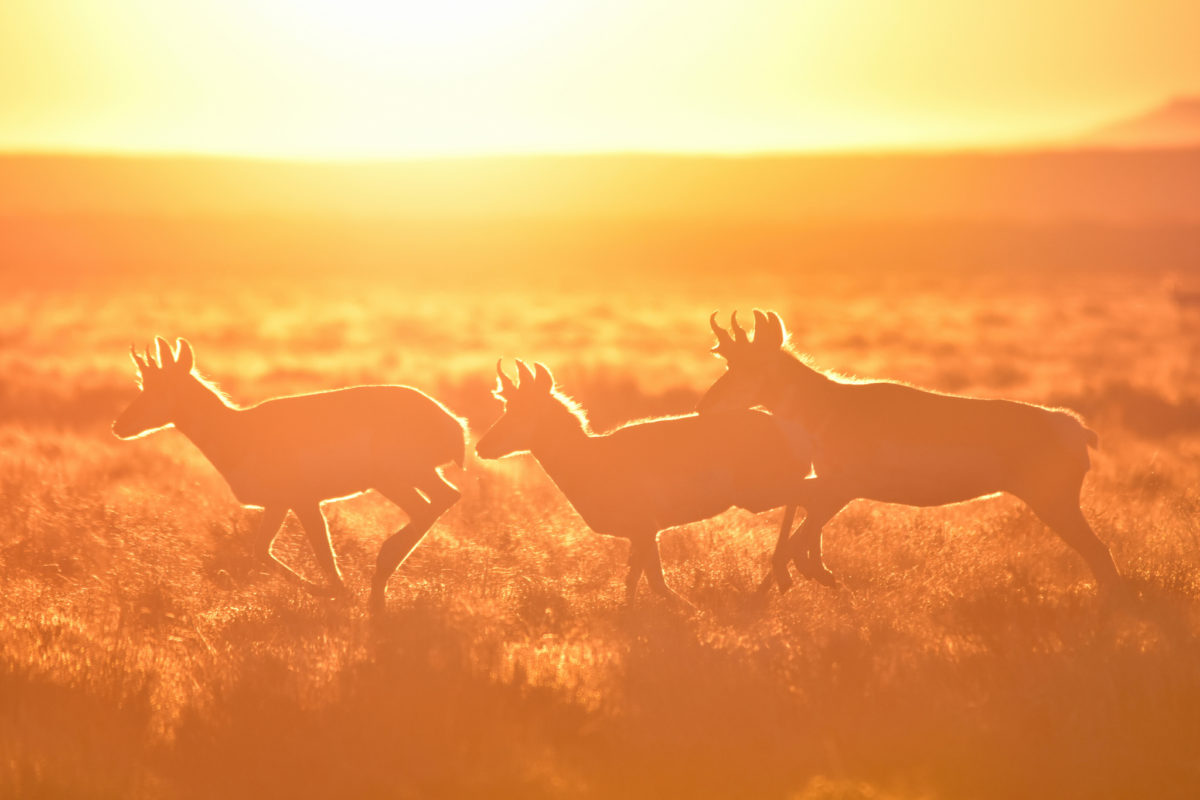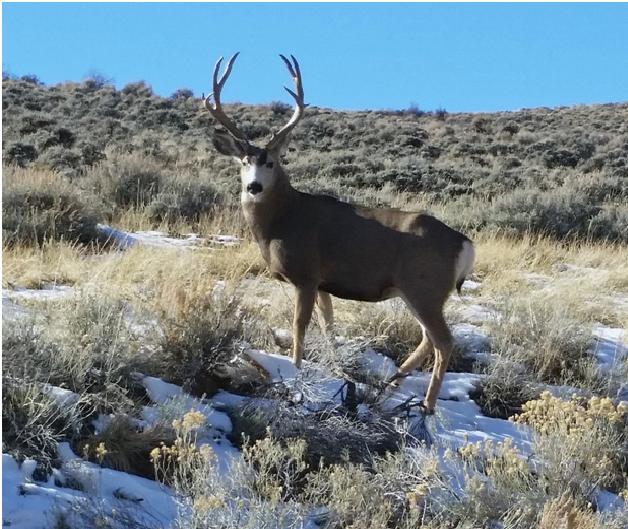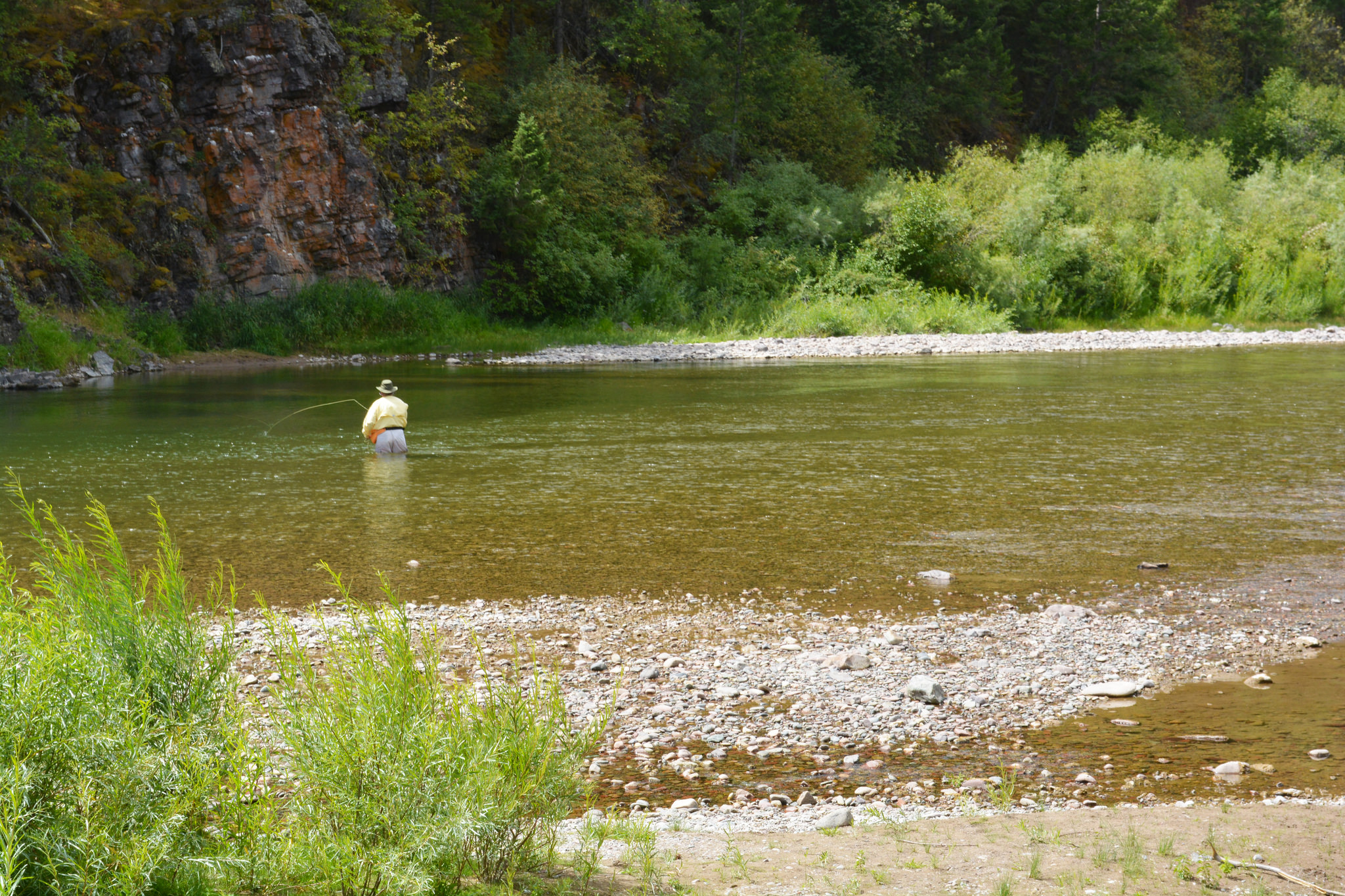mule deer herd_fws
Do you have any thoughts on this post?
Now that breakthroughs in wildlife research and GPS technology have taught us more about big-game migration corridors, we can’t ignore the value of these habitats—we have to conserve them
Wildlife management on public lands has benefited greatly from advancements in technology. In particular, our understanding of how and where big game species migrate has grown exponentially in recent years.
When I was a graduate student researching Rocky Mountain bighorn sheep in the late 1980s, satellite or GPS radio collars were simply not available. Back then, researchers had to capture their study animals, fit them with collars made with technology of that era, and follow animals around trying to determine their locations and habitat-use patterns.
Sometimes this meant three researchers all scrambling up to separate high points to triangulate where an animal was, using a telemetry receiver and antenna. Each one of us would determine the direction of the strongest signal emitting from the animal’s collar, aim a compass in that direction, and plot the bearing on a map. The place where our three lines intersected was theoretically where the critter was located. But times sure have changed.

Today, advances in GPS telemetry are remarkable. Scientists merely have to catch the animals they’re studying to fit them with GPS collars that are accurate to within a few feet. No more worrying about triangulating compass bearings and human error—we know exactly where these critters are spending their time. GPS collars can also be programmed to mark multiple locations for each animal over any desired 24-hour period and automatically send this data to the scientist’s computer, tablet, or smartphone. Software has been developed that can sift through the data and build our maps for us.
Scientists now have the capability to build a travel log for the spring or fall journey of each antelope, bighorn sheep, or mule deer. Locations can be easily plotted in a GIS—a computer system for data related to positions on Earth’s surface—to create accurate, detailed maps showing where the animals traveled, how much time they spent in certain areas, and which habitats they preferred during these annual migrations between winter and summer range.
In Wyoming, scientists used this technology to follow mule deer 150 miles from the Red Desert to Hoback Junction, south of Jackson Hole, and transformed their research into a broader effort called the Wyoming Migration Initiative. Their goal is to advance the understanding and appreciation of Wyoming’s migratory big game species through science and public outreach, and they are currently working to expand to other Western states. This could help broaden the available data and build awareness among sportsmen and women, wildlife managers, and lawmakers across the region.
But the problem remains that our conservation policy and planning tools haven’t been updated, even as we’ve learned so much more, and these critical habitats are still largely overlooked.

The discovery of the Red Desert-to-Hoback migration corridor led the state of Wyoming to revise their policy definitions and develop a strategy for conserving vital migration corridors. This should help the Wyoming Game and Fish Department as they work with the BLM on conserving this often overlooked habitat, so it could be a model to follow.
Hopefully these efforts will help advance conservation with good policy, because when migration corridors are not given this kind of attention, they may be damaged, developed, or lost from the landscape. Loss of these corridors could have drastic impacts on big-game herds, hunting opportunities, and the outdoor recreation economy.
All of the fancy data and maps in the world would be pointless without adequate policy and management actions to conserve the migration corridors that we now understand are important for big game species’ survival. We need to use what we’ve learned to ensure that the iconic big game herds of the west can be sustained well into the future.
Now that mule deer can literally send scientists mobile notifications of their whereabouts and preferences, it’s time for a policy upgrade based on this new information. It’s not enough to maintain and restore the habitat where wildlife spend most of their time, especially if degraded habitat conditions along migration routes can prevent them from getting there.
It is not enough anymore, either, for sportsmen and women to simply fight for keeping public land public. It is critical that hunters and anglers get involved in public land management decisions that could help accomplish more, like conserving migration routes and stopover areas.
Improving the management of our public lands will undoubtedly be a long journey. Sign the petition at sportsmenscountry.org to take the first step.
Top photo by John Carr/USFWS via flickr
This story was originally published February 25, 2016 and has been updated.
Updates to the Missoula Field Office’s resource management plan will help balance multiple uses of 162,000 acres in Montana for the next 20 years or more
The Bureau of Land Management’s Missoula Field Office has revealed proposed updates to its resource management plan, which outlines how more than 162,000 acres of public lands should be managed for the next 20 to 30 years. The planning process helps balance multiple uses of public lands, including much of Johnsrud Park along the Blackfoot River Corridor and sizeable sections of the Garnet Mountain Range and the John Long Range.
“We are encouraged by the direction of this draft plan, which incorporates measures that would benefit fish and wildlife habitat as well as recreational opportunities for Montana sportsmen,” says Scott Laird, Montana field representative with the Theodore Roosevelt Conservation Partnership. “It’s a step in the right direction that reflects the values of local sportsmen and women, so it’s crucial that we remain at the table as this planning process advances.”
The area is popular with hunters for its whitetails, mule deer, elk, and forest grouse, and many of the tributaries to the Blackfoot River and Rock Creek are critical spawning habitat for bull trout and westslope cutthroats.
“The draft plan recognizes the importance of conserving areas that support recreational fisheries and provide valuable access for anglers,” says David Brooks, executive director for Montana Trout Unlimited. “These outdoor recreation opportunities are part of Montana’s identity and define a local way of life. That’s why it’s worth it to plan carefully for the future of these public lands.”

“As a member of the community who also happens to rely on healthy wildlife and dependable hunting seasons to run my business, I’m encouraged by the proposal to maintain certain areas of intact habitat,” says Casey Smith, owner of Straight6Archery. “It’s good for the wildlife we love to pursue and the way people have used this public land for generations.”
The BLM will collect public comments on the draft and host three meetings in Missoula, Phillipsburg, and Lubrecht Forest to open a dialogue with the public on the status of the plan. Based on this feedback, the agency will make revisions and issue an updated resource management plan this spring.
Sportsmen should attend one of the public meetings to learn about the proposed changes, ask questions of BLM staff, and provide feedback to the agency on how you use our public lands. Here are some suggested talking points to take into the meeting:
If you want to know more about how you can make a difference through this public lands planning process, please contact Scott Laird, TRCP’s Montana field representative, at Slaird@trcp.org.
Learn more about the resource management planning process here.
Top photo of the Blackfoot River courtesy of the BLM via flickr.
The organization’s Board of Directors has acquired top talent from REI and Bass Pro Shops and welcomes back leaders of Orvis and Pheasants Forever
The Theodore Roosevelt Conservation Partnership is honored to announce the newest additions to its Board of Directors: Jerry Stritzke, president and CEO of REI; Megan Morris, foundation and philanthropy advisor for Bass Pro Shops; Dave Perkins, vice chairman of the Orvis Company; Howard Vincent, president and CEO of Pheasants Forever and Quail Forever; Mike Nussman, president and CEO of the American Sportfishing Association; and Alston Watt, executive director of the Williams Family Foundation of Georgia.
“This new slate of Board members makes the TRCP a stronger organization,” says Whit Fosburgh, TRCP’s president and CEO. “They include some of the nation’s most prominent names in conservation, philanthropy, and the hunting, fishing, and outdoor recreation industries. Their willingness to serve—or in some cases, serve again—affirms the integrity of TRCP’s bipartisan and science-based approach to safeguarding America’s conservation legacy.”
Stritzke and Morris represent leading outdoor retail brands with impeccable conservation values, while Watt brings experience with non-profit management, fundraising, and philanthropy. Perkins, Vincent, and Nussman are returning to the Board after previously serving full terms.
Four members also concluded their time with the Board in December: John Doerr, previously CEO of Pure Fishing; Mike Fitzgerald, co-owner and president of Frontiers Travel; Jay McAninch, the recently retired president and CEO of the Archery Trade Association; and George Thornton, the recently retired CEO of the National Wild Turkey Federation.
Rod Nelson of Houston, Texas, a former vice president for government and community relations for Schlumberger Limited, was elected as Board chair in December. He replaces Weldon Baird of Atlanta, Georgia, who served as chair for three years.
See the full roster of the TRCP Board of Directors here.
Bios for our newest Board members are below.
Jerry Stritzke joined REI as president and CEO in 2013. Under his leadership, REI launched its extremely successful #OptOutside campaign and reinvested nearly 70 percent of its profits back into the outdoor community in 2017 through co-op members, employees, and nonprofit partners. Stritzke grew up in Oklahoma and enjoys bow hunting, fly fishing, hiking, biking, and cross-country skiing.
Megan Morris is the foundation and philanthropy advisor for Bass Pro Shops, following in her father Johnny Morris’s footsteps as an advocate for local and national efforts to conserve fish and wildlife habitat, connect kids and families to the outdoors, and safeguard hunting and fishing traditions. Morris graduated summa cum laude from the University of Colorado and earned her Master’s in public administration with a concentration in non-profit management from the University of Washington, Seattle.
Dave Perkins joined Orvis in 1979 and is now the vice chairman of retail and sporting traditions, overseeing Orvis retail operations and the company’s core sporting traditions businesses. An avid fly fisherman and wing shooter, Perkins travels extensively to pursue these interests.
Howard Vincent has been with Pheasants Forever for 30 of the organization’s 34 years. In 2000, he was appointed CEO after previously serving as senior vice president and chief financial officer. In that time, it has grown from a $1M to $89M organization, while maintaining 90 percent mission efficiency. He and his wife Wendy have been married for more than 37 years and live in White Bear Lake, Minnesota, where he enjoys chasing the wily ringneck with his two sons, Marco and Ian.
Mike Nussman is the president and CEO of the American Sportfishing Association, having served previously on the Senate Commerce, Science, and Transportation Committee for 9 years. At ASA, Nussman has been a driving force behind numerous pieces of legislation and policy directives to minimize access restrictions, promote clean water, and restore fish populations. He has helped to grow the International Convention of Allied Sportfishing Trades (ICAST) Show and launched KeepAmericaFishing™, the industry’s angler advocacy initiative.
Alston Watt is the executive director of the Williams Family Foundation of Georgia. She previously worked for CARE in Haiti and Bangladesh—administering programs in microcredit, health, and water— and the North Luangwa Conservation Project in Zambia. Watt grew up hunting with her brothers, cousins, and uncle. She has two sons with husband Philip, and their family is never happier than when they are fishing, hunting, and hiking.
Top photo by Dave Nomsen.
Sportsmen applaud proposed enhancements to a popular Farm Bill program that opens public hunting and fishing access on private lands and attracts outdoor recreation spending to many rural communities
Today, Senators Steve Daines (R-Mont.) and Michael Bennet (D-Colo.) introduced new legislation to reauthorize and expand the popular Voluntary Public Access and Habitat Incentive Program—the U.S. Department of Agriculture program that incentivizes landowners to open their property for public hunting and fishing access. The Voluntary Public Access Improvement Act of 2017 received praise from 32 sportsmen’s groups that want to see this valuable federal program continued in the 2018 Farm Bill.
“Nothing beats spending time outdoors hunting, fishing, backpacking—it’s the Montana way of life,” says Sen. Daines. “The Voluntary Public Access Improvement Act will strengthen Montana’s outdoor recreation economy and open up more space for families and sportsmen to enjoy local wildlife in Montana and across the country.”
“This program has rewarded Colorado’s farmers and ranchers for providing new opportunities for the next generation of sportsmen and women and improving wildlife habitat across our state,” says Sen. Bennet. “As we work on the next Farm Bill, we’ll continue to prioritize funding for this successful program.”
VPA-HIP is the only federal program aimed at enhancing access and opportunity on privately owned farms, ranches, and forest lands. The program grants money to states and tribes to support landowners who enroll in the program. Since its reauthorization in the 2014 Farm Bill, wildlife agencies across 29 states and tribal lands have received $40 million to expand public access and enhance wildlife habitat on more than 2.5 million acres.
“Loss of access is one of the top concerns for American sportsmen and women, especially considering the recent decline in hunter numbers,” says Whit Fosburgh, president and CEO of the Theodore Roosevelt Conservation Partnership. “The Voluntary Public Access and Habitat Incentive Program has been a signature issue of ours since the TRCP was founded, and we have worked to see it introduced, implemented, and expanded over the past two Farm Bills. Given its popularity among landowners and sportsmen, we are thrilled that this bipartisan legislation now seeks to provide more funding to enhance the program and keep up with demand.”
“When you combine the Farm Bill programs that help enhance habitat, soil health, and water quality with a stronger, more effective vehicle for opening sportsmen’s access in states that are predominantly private land, it creates a ripple effect in our rural economies,” says Howard Vincent, president and CEO of Pheasants Forever and Quail Forever. “Landowners and sportsmen see a benefit, but more access to healthier fish and wildlife habitat also drives outdoor recreation spending across small communities, from gas stations and diners to motels and sporting goods stores.”
This bipartisan bill supports one of the “Sportsmen’s Priorities for Conservation and Access in the 2018 Farm Bill” agreed upon by the TRCP’s Agriculture and Wildlife Working Group—a coalition of 24 diverse sportsmen’s groups working to enhance conservation in the next Farm Bill.
Read all of the AWWG’s recommendations for the 2018 Farm Bill here.
Learn more about the TRCP’s agriculture and private lands work here.
For more than twenty years, the Theodore Roosevelt Conservation Partnership has been at the forefront of conservation, working diligently on behalf of America’s hunters and anglers to ensure America’s legacy of habitat management and access is protected and advanced. Your tax-deductible donation will help TRCP continue its mission, allowing you to keep enjoying your favorite outdoor pursuits. Whether those pursuits are on the water or in the field, TRCP has your back, but we can’t do it alone. We invite you to step into the arena with us and donate today!
Learn More
